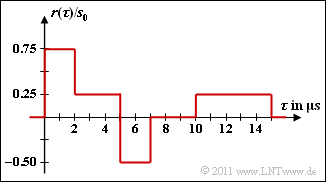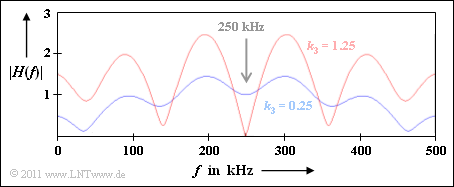Difference between revisions of "Aufgaben:Exercise 2.3: Yet Another Multi-Path Channel"
| Line 109: | Line 109: | ||
\frac {3}{16} \cdot \left [ {\rm e}^{{\rm j}B} + {\rm e}^{-{\rm j}B}\right ]- \frac {1}{8} \cdot \left [ {\rm e}^{{\rm j}(B-A)} + {\rm e}^{-{\rm j}(B-A)}\right ]\hspace{0.05cm}.$$ | \frac {3}{16} \cdot \left [ {\rm e}^{{\rm j}B} + {\rm e}^{-{\rm j}B}\right ]- \frac {1}{8} \cdot \left [ {\rm e}^{{\rm j}(B-A)} + {\rm e}^{-{\rm j}(B-A)}\right ]\hspace{0.05cm}.$$ | ||
| − | Using | + | Using [[Signaldarstellung/Zum_Rechnen_mit_komplexen_Zahlen#Darstellung_nach_Betrag_und_Phase|Euler's theorem]], with consideration of the frequency periodicity, this results in |
:$$|H(f)|= \sqrt{\frac {7}{8 }- \frac {3}{4} \cdot \cos( 2 \pi f \tau_2) + | :$$|H(f)|= \sqrt{\frac {7}{8 }- \frac {3}{4} \cdot \cos( 2 \pi f \tau_2) + | ||
\frac {3}{8} \cdot \cos( 2 \pi f \tau_3)- \frac {1}{4} \cdot \cos( 2 \pi f (\tau_3 - \tau_2))}$$ | \frac {3}{8} \cdot \cos( 2 \pi f \tau_3)- \frac {1}{4} \cdot \cos( 2 \pi f (\tau_3 - \tau_2))}$$ | ||
| Line 118: | Line 118: | ||
| − | '''(6)''' | + | '''(6)''' At $f = 250 \ \rm kHz$, the frequency response is |
[[File:P_ID2162__Mob_A_2_3e.png|right|frame|Amplitude frequency response for three-way channel]] | [[File:P_ID2162__Mob_A_2_3e.png|right|frame|Amplitude frequency response for three-way channel]] | ||
$$H(f = 250\,{\rm kHz})= k_1 + k_2 \cdot {\rm e}^{-{\rm j}\cdot \pi}+ k_3 \cdot {\rm e}^{-{\rm j}\cdot 5\pi} = k_1 - k_2 - k_3 | $$H(f = 250\,{\rm kHz})= k_1 + k_2 \cdot {\rm e}^{-{\rm j}\cdot \pi}+ k_3 \cdot {\rm e}^{-{\rm j}\cdot 5\pi} = k_1 - k_2 - k_3 | ||
\hspace{0.05cm}.$$ | \hspace{0.05cm}.$$ | ||
| − | If you now | + | If you now substitute |
:$$k_3 = k_1 - k_2 = 0.75 + 0.50\hspace{0.1cm} \underline {= 1.25}\hspace{0.05cm},$$ | :$$k_3 = k_1 - k_2 = 0.75 + 0.50\hspace{0.1cm} \underline {= 1.25}\hspace{0.05cm},$$ | ||
the result is $|H(f = 250 \ \rm kHz)| = 0$ and thus the most unfavorable value for this signal frequency. | the result is $|H(f = 250 \ \rm kHz)| = 0$ and thus the most unfavorable value for this signal frequency. | ||
| Line 129: | Line 129: | ||
The graph shows $|H(f)|$ in the range between $0$ and $500 \ \rm kHz$: | The graph shows $|H(f)|$ in the range between $0$ and $500 \ \rm kHz$: | ||
| − | *The blue curve | + | *The blue curve corresponds to $k_3 = 0.25$ according to the specifications of subtask '''(4)''. |
| − | *The red curve | + | *The red curve corresponds to $k_3 = 1.25$, the most unfavourable value for $f = 250 \ \rm kHz$. |
{{ML-Fuß}} | {{ML-Fuß}} | ||
Revision as of 15:19, 15 April 2020
We consider a multipath channel, which is characterized by the following impulse response: $$h(\tau, \hspace{0.05cm} t) = h(\tau) = \sum_{m = 1}^{M} k_m \cdot \delta( \tau - \tau_m) \hspace{0.05cm}.$$
All coefficients $k_{m}$ are real (positive or negative). Furthermore, we note
- From the specification $h(\tau, \hspace{0.05cm}t) = h(\tau)$ you can see that the channel is time invariant.
- Generally, the channel has $M$ paths. The value of $M$ should be determined from the graph.
- The following relations apply to the delay times: $\tau_1 < \tau_2 < \tau_3 < \ \ text{...}$
The graph shows the output signal $r(\tau)$ of the channel when the following transmit signal is present at the input (shown in the equivalent low-pass range):
- $$s(\tau) = \left\{ \begin{array}{c} s_0\\ 0 \end{array} \right.\quad \begin{array}{*{1}c} 0 \le \tau < 5\,{\rm µ s}, \\ {\rm otherwise}. \\ \end{array}$$
We want to find the corresponding impulse response $h(\tau)$ as well as the transfer function $H(f)$.
Notes:
- This task refers to the chapter Mehrwegeempfang beim Mobilfunk.
- For the solution of subtask (1) assume that the impulse response $h(\tau)$ has a span of 5 microseconds.
Questionnaire
Sample solution
The sketched output signal $r(\tau)$ can only result if
- $\tau_1 = 0$ (otherwise $r(\tau)$ would not start at $\tau = 0$),
- $\tau_M = 10 \ \rm µ s$ is (this results in the rectangular section between $10 \ \rm µ s$ and $15 \ \ \rm µ s$),
- there is another Dirac function at $\tau_2 = 2 \ \rm µ s$ between the two.
That means: The impulse response here consists of $\underline {M = 3}$ Dirac functions.
(2) As already calculated in the first subtask, one gets
- $$\tau_1 \hspace{0.1cm} \underline {= 0}\hspace{0.05cm},\hspace{0.2cm}\tau_2 \hspace{0.1cm} \underline {= 2\,{\rm µ s}}\hspace{0.05cm},\hspace{0.2cm}\tau_3 \hspace{0.1cm} \underline {= 10\,{\rm µ s}}\hspace{0.05cm}.$$
(3) If you compare input $s(\tau)$ and output $r(\tau)$, you will get the following results:
- Interval $0 < \tau < 2 \ {\rm µ s} \text{:} \, s(\tau) = s_0, \hspace{1cm} r(\tau) = 0.75 \cdot s_0 \,\,\Rightarrow\,\, k_1 \ \underline {= 0.75}$,
- Interval $2 \ {\rm µ s} < \tau < 5 \ {\rm µ s} \text{:} \, \hspace{2.4cm} r(\tau) =(k_1 + k_2) \cdot s_0 = 0.25 \cdot s_0 \Rightarrow k_2 \ \underline {= \, –0.50}$,
- Interval $10 \ {\rm µ s} < \tau < 15 \ {\rm µ s} \text{:} \, \hspace{1.95cm} r(\tau) =k_3 \cdot s_0 = 0.25 \cdot s_0 \,\Rightarrow\, k_3 \ \underline {= 0.25}$.
(4) Using the time-shifting property, the Fourier transform of the impulse response $h(\tau)$ is:
- $$h(\tau) = k_1 \cdot \delta( \tau) + k_2 \cdot \delta( \tau - \tau_2)+ k_3 \cdot \delta( \tau - \tau_3) \hspace{0.3cm} \Rightarrow \hspace{0.3cm}H(f) = k_1 + k_2 \cdot {\rm e}^{- {\rm j}\cdot 2 \pi f \tau_2}+ k_3 \cdot {\rm e}^{- {\rm j}\cdot 2 \pi f \tau_3} \hspace{0.05cm}. $$
Analysis of the individual contributions leads to the following conclusion:
- The first part is constant (any period is valid).
- The second part is periodic with $f_2 = 1/\tau_2 = 500 \ \rm kHz$.
- The third part is periodic with $f_3 = 1/\tau_3 = 100 \ \rm kHz$.
⇒ $H(f)$ is thus periodic with $f_0 \ \underline {= 500 \ \ \rm kHz}$.
(5) With $A = 2\pi f \cdot \tau_2$ and $B = 2\pi f \cdot \tau_3$ you get
- $$|H(f)|^2 \hspace{-0.1cm} \ = \ \hspace{-0.1cm} H(f) \cdot H^{\star}(f)= \left [ \frac {3}{4} - \frac {1}{2} \cdot {\rm e}^{-{\rm j}A} + \frac {1}{4} \cdot {\rm e}^{-{\rm j}B}\right ] \left [ \frac {3}{4} - \frac {1}{2} \cdot {\rm e}^{{\rm j}A} + \frac {1}{4} \cdot {\rm e}^{{\rm j}B}\right ]$$
- $$\Rightarrow \hspace{0.3cm} |H(f)|^2 \hspace{-0.1cm} \ = \ \hspace{-0.1cm} \frac {9}{16 }- \frac {3 {\rm e}^{{\rm j}A}}{8} +\frac {3{\rm e}^{{\rm j}B}}{16} - \frac {3{\rm e}^{-{\rm j}A}}{8} +\frac {1}{4}- \frac {{\rm e}^{{\rm j}(B-A)}}{8} +\frac {3{\rm e}^{-{\rm j}B}}{16} - \frac {{\rm e}^{{\rm j}(A-B)}}{8} +\frac{1}{16 }=$$
- $$\hspace{2.1cm} \ = \ \hspace{-0.1cm}\frac {7}{8 }- \frac {3}{8} \cdot \left [ {\rm e}^{{\rm j}A} + {\rm e}^{-{\rm j}A}\right ]+ \frac {3}{16} \cdot \left [ {\rm e}^{{\rm j}B} + {\rm e}^{-{\rm j}B}\right ]- \frac {1}{8} \cdot \left [ {\rm e}^{{\rm j}(B-A)} + {\rm e}^{-{\rm j}(B-A)}\right ]\hspace{0.05cm}.$$
Using Euler's theorem, with consideration of the frequency periodicity, this results in
- $$|H(f)|= \sqrt{\frac {7}{8 }- \frac {3}{4} \cdot \cos( 2 \pi f \tau_2) + \frac {3}{8} \cdot \cos( 2 \pi f \tau_3)- \frac {1}{4} \cdot \cos( 2 \pi f (\tau_3 - \tau_2))}$$
- $$\Rightarrow \hspace{0.3cm} |H(f = 0)|\hspace{-0.1cm} \ = \ \hspace{-0.1cm} \sqrt{\frac {7}{8 }- \frac {3}{4} + \frac {3}{8} - \frac {1}{4} } = \sqrt{0.25}\hspace{0.1cm} \underline {= 0.5} = |H(f = 500\,{\rm kHz})|$$
- $$|H(f = 250\,{\rm kHz})|\hspace{-0.1cm} \ = \ \hspace{-0.1cm} \sqrt{\frac {7}{8 }- \frac {3}{4} \cdot \cos( \pi ) + \frac {3}{8} \cdot \cos( 5 \pi )- \frac {1}{4} \cdot \cos( 4 \pi )} \hspace{0.1cm} \underline {= 1}\hspace{0.05cm}.$$
(6) At $f = 250 \ \rm kHz$, the frequency response is
$$H(f = 250\,{\rm kHz})= k_1 + k_2 \cdot {\rm e}^{-{\rm j}\cdot \pi}+ k_3 \cdot {\rm e}^{-{\rm j}\cdot 5\pi} = k_1 - k_2 - k_3 \hspace{0.05cm}.$$
If you now substitute
- $$k_3 = k_1 - k_2 = 0.75 + 0.50\hspace{0.1cm} \underline {= 1.25}\hspace{0.05cm},$$
the result is $|H(f = 250 \ \rm kHz)| = 0$ and thus the most unfavorable value for this signal frequency.
The graph shows $|H(f)|$ in the range between $0$ and $500 \ \rm kHz$:
- The blue curve corresponds to $k_3 = 0.25$ according to the specifications of subtask '(4).
- The red curve corresponds to $k_3 = 1.25$, the most unfavourable value for $f = 250 \ \rm kHz$.

